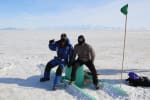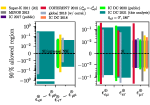The Wisconsin IceCube Particle Astrophysics Center (WIPAC), a research center that is part of UW–Madison’s Office of the Vice Chancellor for Research and Graduate Education and headquarters for the IceCube Neutrino Observatory, is back at the Holiday Fantasy in Lights event in Madison, Wisconsin! WIPAC participated in the annual holiday exhibit for the first time last year with […]
News
Meet IceCube’s 2021-2022 winterovers, Moreno and Celas!
It’s that time of the year when last year’s winterovers are finally relieved of their duties as a new crew arrives at the South Pole. “Winterover” is the name given to the brave individuals who sign up to live and work at an Antarctic field station for a full year—sometimes longer—half of which is spent […]
Week 43 at the Pole
The IceCube detector may have been quiet, but there was plenty of other activity last week at the Pole. First up, shoveling snow. IceCube winterovers tackled the mounds of snow that had accumulated on the steps and platforms outside the IceCube Lab. Above is the “after” photo, below is the same spot only a week […]
IceCube-Gen2 convenes to kick-off technical design report
The IceCube-Gen2 Collaboration recently wrapped up a weeklong kick-off meeting to formalize a technical design report for the project. With over 100 participants and 50 talks, the interdisciplinary workshop brought together scientists and engineers from around the world to discuss the status of design and performance requirements that will lay the foundation for IceCube-Gen2’s technical […]
Week 42 at the Pole
Another plane arrived at the Pole last week to refuel before continuing on to McMurdo Station. This one, however, departed with a couple of additional passengers. Two of the 39 winterovers who have been isolated at the South Pole station for the past nine months boarded that plane as the first leg of their journey […]
IceCube conducts a search for multiple flaring episodes from neutrino sources with 10 years of data
The IceCube Neutrino Observatory, a peculiar telescope located in the ice of the South Pole, was built to detect mysterious particles called neutrinos that come from outer space. To pinpoint their cosmic sources, IceCube researchers look for unexpected excesses of neutrinos coming from localized directions in the sky. In a paper published in 2020, IceCube […]
Week 41 at the Pole
What started out as a relatively quiet week at the Pole ended with some excitement. First, there was an incoming flight. After eight months of isolation, these were the first visitors to arrive at the station. But they only stopped briefly to refuel on their way from Rothera Research Station to McMurdo Station. Since outdoor […]
Week 40 at the Pole
Last week was relatively quiet at the Pole. But with station opening just a few weeks away, the station personnel had their final all-hands meeting, at which they held their yearly raffle of flags that had been outside all winter. The harsh elements take a toll on these flags, so come summer, they get replaced, […]
IceCube analysis puts most general constraints on nonstandard neutrino interactions
For decades, physicists have theorized that the current best theory describing particle physics—the “Standard Model”—was not sufficient to explain the way the universe works. In the search for physics beyond the Standard Model (BSM), elusive particles called neutrinos might point the way. Neutrinos are sometimes called “ghost particles” because they so rarely interact with matter […]
Week 39 at the Pole
Last week, the intrepid South Pole station winterovers got themselves together (all but two of them!) for an outdoor group photo. With the sun out, it’s easy to forget just how cold it is there. They picked a vantage point behind the South Pole Telescope where the other major facilities could be seen on both […]









